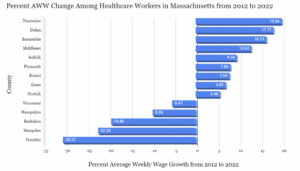Average Weekly Wages of Healthcare Workers Across a Decade
The healthcare industry is facing a huge employment crisis that is often cited as the result of an aging population. Hospitals and other healthcare establishments around the nation are experiencing staffing shortages, and Massachusetts – especially Boston – is no different. The city has some of the best hospitals in the world, and the fact that they are experiencing a labor shortage is symbolic of the industry nationwide. Why does this lifesaving industry experience these problems?
The first thing to acknowledge is that healthcare jobs are both stressful emotionally and physically demanding. A study from Vivian Health revealed that healthcare professionals experience the most work-related stress, but have lower levels of “stress-related absences” due to the vitality of their profession and the immediacy of patient needs.
Healthcare professionals are essential to making society function; however their wages, and specifically their wage growth from 2012 to 2022, are lackluster compared to other industries. The healthcare and social assistance sector is part of the most general level of the North American Industry Classification System and encompasses employees in the field of medicine.
Utilizing data retrieved from MassEconomix, of the fourteen Massachusetts counties, five experienced a decline in average weekly wages (AWW) for healthcare and social assistance during the period, which is the most of any large industry sector. For example, the finance and insurance sector experienced a 23.6 percent increase across the fourteen counties, with no county suffering from a decline in AWW. The construction sector did not have as dramatic an increase as finance and insurance, with a 14.1 percent increase in AWW, but there was no county in which construction wages declined. The same was true in every sector except healthcare and social assistance.
Of the counties in which healthcare AWW increased, few rose significantly. Nantucket County experienced the largest increase in AWW at 19.66 percent, but the other counties, on average, experienced growth of about 9.6 percent during the decade. The other two counties with the largest increases were Dukes (Martha’s Vineyard), and Barnstable (Cape Cod), with a 17.77, and 16.13 percent growth, respectively. Middlesex County had the next highest growth, but it is still nearly four percentage points lower than Barnstable County.
Few other industries in Massachusetts rank as poorly as healthcare in wage growth. Berkshire, Franklin, Hampden, Hampshire, and Worcester counties all experienced a decline in AWW. In 2022 these counties employed 154,032 individuals in the healthcare and social assistance sector. Of the counties with increasing AWW, five (Bristol, Essex, Norfolk, Plymouth, and Suffolk) grew by less than 10 percent over the decade. These counties employed 346,620 healthcare and social assistance workers in Massachusetts in 2022.

Data retrieved from MassEconomix
Dana DiChiro is a Roger Perry Government Transparency Intern at the Pioneer Institute for Summer 2024. She is a rising senior studying Government & Politics and Economics at the University of Maryland, College Park.



